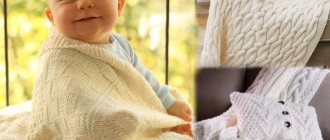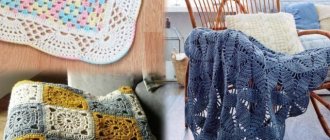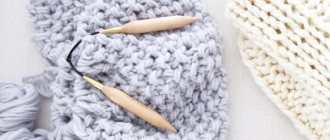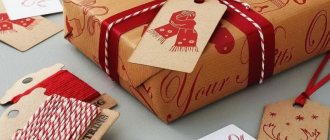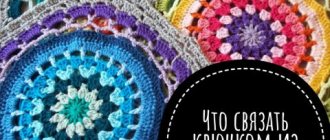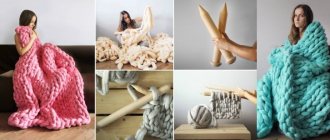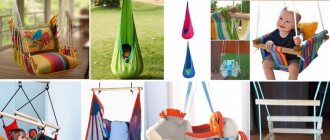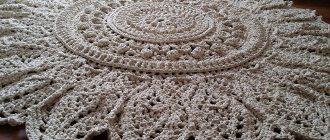Moms who know how to knit, create original, unique things for children. Stroller, crib, walk, check-out, nap - a hand-knitted blanket will come in handy everywhere. This article will tell you what size it is made and how to choose threads, introduce you to simple patterns and patterns, and offer a master class on making it.
How to choose yarn for a knitted baby blanket
For children they choose everything natural. Cotton - does not cause allergies, breathes. It is easy to care for, but the product is quite heavy for a baby. Usually, mixed yarn is selected with the addition of bamboo or silk. Wool and mohair retain heat and remove excess moisture from the body, but can cause allergies and itching. Long lint gets into the mouth and nose. The thing loses its shape and stretches. Synthetic additives to them provide elasticity, lightness and retain heat. Acrylic is a bright, durable artificial material that can be added to natural fibers or used separately.
The inscription “children’s” is characterized by a mixed composition and undergone special heat treatment. The item will be distinguished by its softness, lightness, and cheerful shades. Recommendations for selection:
- summer model – cotton and acrylic are present in equal proportions;
- off-season - any wool and the same amount of acrylic;
- warm option - alpaca, acrylic, but alpaca is twice as large.
The addition of synthetics increases strength, ensures the disappearance of deformation, and allows you to paint in bright colors. The item lasts longer, despite frequent washing.
Yarn selection
The quality and density of the threads primarily depend on the time of year in which the baby is due to appear. For babies born in spring or summer, choose lighter yarn, for those born in winter or autumn, choose warm and dense yarn. When purchasing, you should take a closer look at their labeling. It is advisable that the label indicate that the yarn is intended for children's clothes.
Yarn selection table for the baby's birth season:
| Winter | Summer |
| Wool. The threads are made of 100% natural wool, dense and soft. However, the individual characteristics of the child should be taken into account, since pure wool is not suitable for sensitive skin. | Cotton. The yarn is 100% mercerized cotton. The quality of the threads will increase the density and reduce the tendency of the product to damage significantly. You can also find cotton yarn without mercerization. These threads are very soft and thicker. However, it is worth paying attention to the fact that products made from them require careful handling. |
| Wool + bamboo + acrylic. Good for kids prone to allergies. At the same time, the product will be quite soft and warm. | Cotton + polyacrylic. For those who find cotton too stiff, you can choose a blended thread. The blanket will be soft and pleasant to the touch. |
| Wool + acrylic + alpaca wool. A blanket made from such threads will be very light and warm at the same time. | Acrylic. Pure acrylic threads are dense and pleasant to the touch. For children's clothes, you should definitely choose acrylic yarn marked “baby”. |
You should know that:
- The cotton thread should be dense, without thickening or tears . A product made from such yarn requires more threads due to the fact that they are thinner than acrylic or wool. A blanket made of very thin threads will wear out quickly.
- You should not buy woolen threads with long lint, which can get into the baby’s mouth or nose. You also need to carefully check the quality of the yarn. Real wool fibers should not break when stretched. It is better to try the yarn in advance by touching it to your cheek or other part of the body and, if unpleasant sensations appear, refuse to purchase.
- Low quality acrylic threads will creak when knitting ; they are not intended for babies. Products made from acrylic may stretch if washed frequently.
What sizes are blankets for newborns?
The size of the product depends on its use; it is often prepared for a special event - for discharge to the maternity hospital. Children's height is about 55 cm, add 10-20 cm - you get the necessary data. The child is growing quickly, but for some time the blanket will serve as a blanket in the crib or on a walk. To extend its use, increase the sides to 90 cm.
Important! A simple blanket in the stroller covers the child, does not stick out or drag on the ground.
The basis is the size of a suitable diaper for a baby - a 75 cm square or a 90x75-80 cm rectangle. For winter, they make a larger one - 90x120 cm, to make it more convenient to wrap the baby.
For a daughter or son - a snow-white blanket for discharge from the maternity hospital
An openwork pattern is best suited for a newborn (regardless of gender). It makes the product “airy” and looks gentle and elegant. It may seem that this is a very delicate work that requires mastery of knitting needles, but knitting a baby blanket with openwork with hexagon motifs is not a very difficult technique. Garter stitch is used, hexagonal and triangular parts are knitted according to the attached patterns.
Necessary materials:
- white acrylic yarn - 350 g;
- knitting needles No. 3.5.
Step-by-step description of the process:
- Knit 22 hexagons 20 cm high according to pattern 1. For each, cast on 8 stitches. In the first row after the edging there is the following rapport: knit 1, yarn over. Repeat this combination 6 times, finishing with an edge row. Knit a total of 36 rows and bind off the stitches.
- Knit 6 “half-hexagons”, repeating the same rapport 3 times.
- Sew all the side parts of the hexagonal elements one to the other, connecting 1 to 2 and so on.
- On the sides of these figures, pick up 20 stitches for triangles. Purl the row. Knit further 17 rows according to pattern 2.
- In the 18th row (it should be purl) knit 3 stitches. purl together, 2 stitches. purl together, then place the first loop over the second and knit them at the same time. In this way, make triangles by connecting hexagons with their halves (according to the numbering on the drawing).
- To assemble the blanket, pick up 200 stitches along the edges of each side, knit 5 cm, increasing on both sides in every second row 10 times in one loop.
- Close the loops.
- Sew the edges of the trim.
The nuances of calculating the amount of yarn for knitting
In popular magazines on needlework, all the necessary information is indicated next to the model: weight, fiber thickness, tool number, density per 10 cm. Choosing another model - you will need to carry out this calculation yourself:
- take similar fiber from your supplies or buy 1 skein;
- knit a 10 cm square;
- wash;
- dry;
- dissolve the sample;
- measure length;
- count how many such squares will fit in the area;
- multiply the resulting number by the length of the thread;
- add a margin of 10-20% - the calculation has been completed.
Important! The label from the skein is kept until the end of the work - it will help to buy an additional skein if the calculation is carried out incorrectly.
Approximate weight for a baby blanket with knitting needles: newborn – 700 g, stroller – from 500 g, crib – 800 g or more. The consumption depends on the chosen motif: “braids” will require additional thread consumption, an openwork , loose version will require less.
Note! Loose knitting looks good with fluffy yarn.
Popular patterns for children's blankets
A blanket is a flat canvas on which a pattern or alternation of fragments looks great. With lace rapport, there is no need to create large arches so that the baby does not get his fingers into them and does not get confused.
Most often, they take the most common pattern - a shadow surface, which is decorated with openwork patterns, volumetric elements on any theme, or decorated with a large fragment on the outside. An original knitted blanket for a newborn is made using sectional dyeing and melange.
Additional Information! Crossed loops (“braid”, “harness”) reduce the width of the item.
A thick plush blanket is created by choosing the simplest patterns. There are various patterns created by alternating the basic types of loops. An experienced master comes up with them himself.
Models for any age
For older people, you can use the large method and knitting elements. The thickness of the product can be denser and more voluminous.
Bedspread with braids and fringe
The pattern is simple to make - for a braid, type 6 L, and for a path between them - 6 I. Alternating motifs allows you to achieve a convex pattern and tight knitting. They knit 4 rows, intertwine the braids and knit another 4 rows. The alternation is repeated. The result is a voluminous and beautiful drawing.
Instead of embossed braids, choose a pattern. The back and front sides look equally beautiful. The size of the future product will be 121*161 cm. Cast on the knitting needles 144 P and knit in a pattern. At a height of 160 cm the hinges close. Knitting a blanket begins with alternating L and I. The first row is knitted 2 L and 2 I. Next, focus on the execution pattern. The third row is dialed 2 I, 2 L and repeat.
Patterns and descriptions of knitting according to them
A few simple motifs for knitted blankets for newborns:
"Chess" includes squares of any size. Consider 6x6:
- alternation of 6 persons. 6 purl;
- five rows - in accordance with the resulting image;
- change in order - the type of loops is changed to the opposite;
- six rows - according to the drawing;
- change to the opposite type.
The required number of loops for the set is calculated using the control sample - an integer number of squares plus 2 edge loops.
“Polish elastic band” is great for kids: the number dialed is divided by 4, 2 loops are added. Scheme:
- rapport – 2 persons. 2 purl;
- odd rows - purl, repeat repeat;
- even rows – sequential execution of rapport.
“Wave”: the number of loops is divided by 11 plus the additional two outer loops. Description:
- odd - together two for the lower part, k3. Yarn over, knit, yarn over, knit 3, knit 2 together for the top;
- even, 11 and 13 – purl. loops;
- 12 and 14 – facial loops.
Simple drawing. You need to cast on a number of stitches that is a multiple of 17 plus 2.
- odd - knit, purl;
- even - purl, knit three.
Braided beauty
A knitted product with braids or plaits is always original and stylish. It will be easier to knit when there is a description for the pattern. From a huge number of options, you can choose the simplest one for yourself.
A blanket can be knitted not only for a baby, but also for an adult as a gift, if he can appreciate it.
As an example, you can knit a baby blanket with a pattern of simple braids.
Pattern repeat consists of 18 loops plus 2 outer loops.
- Row: P1, *K1, P1, K6, P1, K6, K1, K1, K1*;
- row: loops according to the pattern;
- p: like the first;
- p: like the second;
- r: 1 purl, * 1 l. remove without knitting, 1 purl, 3 knits on an additional needle in front of the product, 3 knits, and then 3 knits with an additional needle. knitting needles, purl 1, 3 l. on a spare needle in front of the product, k3, and then k3. with additional knitting needles, purl 1, 1 l. remove without knitting, 1 purl*;
- r: like 2nd.
How to knit a plain blanket for a newborn with your own hands: a step-by-step guide
To knit a plain baby blanket for newborns, a simple motif for a square of 80 cm will suit beginners. You will need 350 g.
It’s useful to know, read: – What ways can you wrap blankets as a gift?
Set of loops
You need to start with a set of 175 loops. The fiber is unwound from the skein, thrown over the index finger and thumb, forming a figure eight. Take both needles, insert them into the threads, make a loop and tighten it. The steps are repeated, after completing the set of loops, one needle is removed and the main part of the work begins.
Basics
The beginning consists of 10-11 rows - the edge, which is decorated using a scarf method. The first edge loop is done with a knit stitch, and the last one with a purl stitch. In the 10-11th row, yarn overs are formed, first after 11 loops, and then every 18 loops.
The first 7 and last 7 stitches are garter stitch. To design the canvas, a pattern of 24 rows in height is used:
- 1, 3, 9, 11,14, 16, 22, 24 – knit 9, purl 9, yarn over is knit crossed;
- 2, 4, 10, 12, 13, 15, 21, 23 – without double crochet, the progress is reversed;
- 5, 7, 17, 19 – k3, p3;
- 6, 8, 18, 20 – the previous version, the order of the loops is the opposite.
Having knitted the required height, reduce the width - connect two loops at a time: first after 11, and then every 18 loops. Garter knitting is similar to getting started.
Ending
The first and second loops are knitted separately, then holding the first with a needle and fabric, pull the second through it - one loop is formed from the two. The procedure is repeated along the entire length. The tip is carefully secured.
Read, it’s useful to know: – Descriptions and patterns of crocheting blankets for beginners.
Decoration
The finished product is washed, dried laid out on the surface, and given the correct shape. A dry bedspread is decorated by sewing ribbons or lace with a strong thread. Use a hook to decorate the outline along the edge.
Bedspread lining
To make the bedspread really warm, you can reinforce it with a lining. For lining, experts recommend:
- cotton fleece or Italian anti-pilling fleece, which is highly wear-resistant;
- good quality bike;
- cotton jersey in interesting colors.
The purchased fabric needs to be washed and ironed so that it shrinks. Since you will have to sew on the lining manually, you need to fold and iron the fabric around the entire perimeter. Using a blind stitch, the lining is carefully sewn to the finished bedspread.
Knitting a baby blanket with patterns is a fun and useful activity. The baby will be warmed not only by the blanket, but also by your care.
Originally posted 2018-04-18 13:46:16.
How to knit a colored blanket: master class
A colored blanket for a newborn can be knitted with knitting needles No. 5.5 from four skeins of 170 g each. Three stripes are made with the main pattern, and the edges and dividing stripes are made of pearl or rice. The blanket will turn out bright, cheerful, and festive. You will need four shades of yarn.
Step by step description:
- cast on 129 loops;
- six rows are knitted in “pearl” or rice, taking color No. 1: knit. purl;
- Row 7 - like the sixth, four loops at the end - in reverse;
- 8-12, 14-18 rows – front;
- Row 13 – repeat *K8. yarn over, cross two and knit*, at the end - 4 loops;
- Row 19 – knit 4. repeat *yo, two crossed together, knit 6*, at the end knit 4. and five loops.
- repeat from 8 to 19 twice;
- repeat from 8-12;
- separating “pearl” color No. 2;
- lane No. 3 – as No. 1;
- separating “pearl” color No. 2;
- lane No. 4 – as No. 1;
- 6 rows “pearl” pattern;
- closed in any way.
Note! The edge loop is first simply removed.
Multicolored plaid
Multi-colored blanket knitted using the spiral knitting technique
You will need long knitting needles, as well as yarn of three or four colors. If a product is knitted for a child, usually no more than twenty squares are knitted, each of which is about 17 cm in size.
Even a novice knitter can knit a chic multi-colored blanket with knitting needles in a simple pattern.
The whole point of knitting is alternating knit and purl stitches. For particularly large work, 3-4 loops are usually alternated.
Knitting a baby blanket from parts
The patchwork style looks original on kids, which is why it is often used. The simplest option is to prepare about 20-24 squares with a side of 16-17 cm, and then connect them together. It turns out: width 68 cm, height 85. They use different shades, a scarf motif. Connect with a regular or decorative seam or crochet. Processed - turn the outer side towards you, sweep the thread around the perimeter. Originality is not in the beauty of the image created by the threads, but in the chosen colors and the sequence of joining.
Important! The fibers on a knitted blanket for a newborn must be of the same thickness.
Knitted openwork blanket for a child
A light openwork motif is made from acrylic yarn, knitting needle No. 4. Execution order:
- cast on 15 loops;
- front, back;
- purl/p, l/p – reverse order;
- from the third to the seventh row - like the previous row, changing the type of loops in a checkerboard pattern;
- purl;
Important! In the main part, the first and last 6 loops are performed in a “tangle” everywhere.
- persons, repeat 13 times, starting from the second line of the description;
- the main description is performed 20 times in height;
- 7 rows - work as at the beginning;
- last row - the loops are closed.
The result is a blanket with “holes” that the baby will enthusiastically study.
A knitted blanket for babies, created for a special event or for every day, is the work of one person. Various threads are suitable, but preference is given to “children’s” yarn. Pattern, color, thread thickness, needle numbers - everything affects the appearance of the resulting product. You can find the work procedure on the Internet or calculate it yourself.
Blanket with sailboat
A beautiful children's blanket with an anchor and a sailboat for a future sailor
The drawing diagram includes 4 parts, each of which represents a specific part of the image.
Cast on 124 stitches. To make the edging, knit the first and last 7 rows with a “rice” pattern, and use it to decorate the first and last 7 loops of each row.
The pattern of the “rice” pattern is not at all complicated. It can be found in almost all resources.
Knitting pattern “Rice”
This article presented the most common methods of knitting a baby blanket with your own hands.
A children's blanket can be lined to avoid irritation from warm wool options
A blanket created with soul will keep your child or grandchild warm for many years, because handmade work will never become obsolete or go out of fashion.
A set of children's blankets for any occasion
